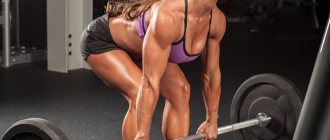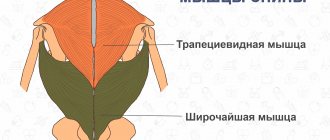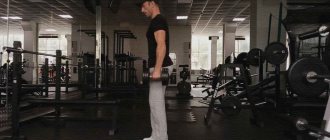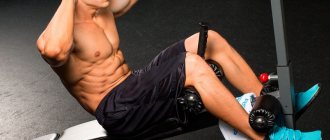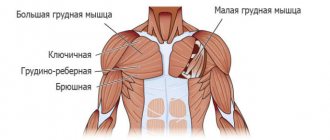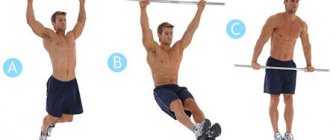Is your dream to have wide and strong back muscles? From this article you will learn about the best exercises with which you will definitely achieve what you want!
The best exercises to quickly build up a wide back
Back muscles are an important component of a beautiful figure for men and girls. Building a wide and massive back is incredibly difficult.
At the gym, people work to build muscle by doing a wide variety of exercises. In pursuit of the ideal form, they do not notice their mistakes, which significantly affect the achievement of the result.
From this article you will learn a lot of useful information, which you can acquire and get on the path to progress.
Back muscles and their functions
The back muscles are the largest after the leg muscles. Therefore, their training should be voluminous and intense. These muscles are divided into deep and superficial. We train superficial ones in the gym.
The main functions of these muscles:
- ensuring mobility and stabilization of the spine;
- keeping the neck and torso in an upright position;
- maintaining the natural curvature of the spine;
- shock absorption and compression load on the spine;
- assistance in movement of the upper limbs;
- providing various tilts and turns of the head.
They are antagonists of the pectoral muscles. With their help we can do various pulling movements. Guys who like to bench press a lot and often should remember that an imbalance in the development of the chest and back causes a person to involuntarily slouch, which can subsequently cause the development of the notorious scoliosis.
I would like to note right away that to build a wide and sculpted back, it is necessary to train all its muscles, regardless of their functions.
Features of training programs for back muscles
A well-designed training program includes complex multi-component back exercises that involve several muscle areas at once.
Isolation exercises can also be included in the training plan, but they should be performed only after the basic ones.
The following will present a simple but effective example of a training program for the back muscles. Perform this set of exercises once a week for the next 8 weeks and see how your body reacts. You will be pleasantly surprised.
- Deadlift - after warming up, do 3 working sets of 4-6 reps with a weight equal to 85% of your one-rep maximum;
- Bent-over barbell rows – 3 sets of 4–6 reps;
- Wide grip lat pulldown – 3 sets of 4–6 reps;
- One-arm dumbbell rows - 3 sets of 4-6 reps.
Remember that you need to gradually increase the weight of the projectile. This is the only way you can progress. Lifting the same weight, you will continue to mark time.
If you do 6 reps with a weight of 100 kg, then add 2.5 kg on each side. If on your next set you do 4 reps with the new weight, then it becomes your work load until you do 6 reps.
If the new weight is difficult for you and you can only do 3 repetitions, then you should reduce the weight a little and work with it. Once you've done 2 sets of 6 reps with that weight, move on to the next one.
This technique is ideal for both men and girls.
Rest between sets
Rest is a very important part of the training process. If you choose the wrong time to rest, the effectiveness of your workout may decrease. By taking little time to rest between sets, you won't have time to recuperate before putting a new dose of stress on your muscles. If the pause is too long, the muscles will cool down and it will be difficult for you to start working again.
When performing heavy exercises, 3 minutes of rest will be enough for you.
Diet
Make sure you are consuming enough nutrients. You need protein to grow muscles, and carbohydrates to restore energy. A balanced diet has a tremendous impact on your progress.
Sports nutrition
In fact, in order to start building your body, a balanced diet and a well-designed training program are enough. But sports nutrition will allow your body to receive additional calories and a dose of amino acids, which are necessary for building muscles.
Don’t believe the advertising and rush to the store, sweeping all the sports nutrition off the shelves. Enough to stock up on the essentials.
- Creatine
It is a natural compound that is produced in the body from amino acids such as arginine, glycine and methionine. Contained in meat and fish.
Beneficial properties of creatine: increases performance, promotes strength and high-quality muscle mass.
Not recommended for use by people with kidney disease.
- Protein
Protein is a sports supplement that consists of protein mixtures. When digested, protein is broken down into amino acids, which are the main building blocks for muscles.
If you can't get enough protein from food, add protein to your diet.
- Pre-workout complex
A type of sports nutrition that helps increase endurance and makes training more productive. It is important not to make a mistake when choosing a pre-workout complex, because not all are effective and safe.
Back width
All movements in which we pull weights from above to the chest involve the muscles of the upper back. They, by and large, create visual width. Therefore, to build a “cobra” back, you should focus on various pull-ups and vertical rows.
Bodybuilder Sergio Oliva, a three-time winner of the Mr. Olympia title, among other things, had an incredibly wide back. He says that to develop it, every day, at the beginning of any workout, he performed 5 sets of 20 pull-ups on the horizontal bar.
Because the latissimus dorsi muscle helps pronate the humerus, you should constantly vary your grip. For its comprehensive development, it is also necessary to regularly change the width of the arms.
Method 1. Back exercises with your own body weight
The first complex is suitable for training for those who want to pump up their back muscles without exercise equipment or additional weights.
Inverted snow angel
For this exercise, you need to spread your arms wide, describing a circle, as if you were back in childhood, frolicking in the snow. At the same time, the arms move through the full amplitude of the “angel wings” - from behind the head to the hips - for a total development of the trapezius, latissimus, rhomboid and extensor muscles. When you can keep your torso and arms above the floor, move your shoulders back and maintain this position for maximum muscle tension.
- Lie face down on the floor or mat. Extend your arms along your body, palms down.
- Slowly extend your arms out to the sides until you touch the back of your head, connecting your thumbs.
- Slowly return your hands to the starting position. Make sure your arms are straight and your elbows are firmly locked throughout the exercise.
- Do three sets of five reps. Rest 30-60 seconds between sets.
- If you are a beginner and find it difficult to move through the full amplitude, you can raise your arms to shoulder level. Gradually your muscles will become stronger and you will be able to move them behind the back of your head.
Standing body bends
This simple exercise, also called the "good morning" exercise, involves bending your body forward while flexing your hips. By performing this simple movement that does not require any additional equipment, you will work the extensors of the spine (as well as the buttocks and thigh muscles).
- Stand straight with your feet slightly wider than shoulder-width apart. Place your hands on your sides.
- Pull your shoulders back slightly to activate your back muscles.
- Slowly bend forward at the waist. Make sure your shoulders remain in line with your hips as you bend over.
- Bend down until parallel to the floor, and then slowly return back.
- Perform the exercise at a slow pace, tensing your abdominal muscles as much as possible.
- Start by doing one set to make sure it's right for your back. Gradually increase the number of sets to three, 10-15 repetitions. The pause between approaches should be 30-60 seconds.
- The exercise can also be done while sitting. Sit on a chair with your back straight and your feet flat on the floor in line with your knees. Place your hands on your belt. Spread your shoulders, squeezing your back muscles, and bend forward to a 45-degree angle.
- Make sure that your back does not bend during the exercise, otherwise you will not only not work your back muscles, but also damage your spine.
Superman
This is an excellent exercise for training the spinal extensor muscles, buttocks and trapezius. You don't need any equipment, just space to stretch out on the floor. By imitating Superman's flight, you can work your core muscles in isolation.
- Lie on your stomach with your legs and arms extended straight. Palms and toes point down.
- Lift your straight arms and legs off the floor. Keep your body still. Imagine Superman stretched out in flight.
- Hold this position for 15-30 seconds, and then slowly lower your arms and legs.
- Do the exercise three times, then rest for 30-60 seconds. before the next approach.
- To work the deep muscles of the lower back, you can try an exercise called Aquaman. Here you need to lower and raise the opposite arms and legs (for example, the right arm and left leg), holding at the top point for 13-15 seconds. Then repeat the exercise for the other arm and leg.
- Beginners can hold Superman for 5 seconds, gradually reaching 15-30.
Yoga Cobra Pose
This asana for beginners engages the muscles of the middle and lower back, improving flexibility.
- Lie face down on the floor. Stretch your legs, touching the floor with the backs of your feet. Pull your arms bent at the elbows towards your body, placing your palms under your shoulders.
- Tighten your lower back muscles to lift your body off the floor. Help yourself by pushing with your hands. Press your feet, legs, and thighs toward the floor. Rise up as you inhale.
- Hold the position for 15-30 seconds, breathe freely.
- Exhale and slowly return to the floor.
- Do it 10 times. As with any exercise, try to hold on a couple of seconds longer each time. This exercise can not be done every day, a couple of times a week is enough.
Wall Squats
For this simple exercise, all you need is a wall. By performing this movement, you can prevent or relieve lower back pain that occurs throughout the day.
- Stand with your back to the wall, feet shoulder-width apart, heels a step away from the wall.
- Slowly slide down the wall until your knees form a 90-degree angle. Hold the position for 5 seconds.
- Slide up the wall at a slow pace until you are completely straight. Repeat five times.
Pull-ups
For this exercise, you need to pull your torso up towards a fixed bar. This is one of the simplest and best exercises for the latissimus muscles. You will need a horizontal bar that you can attach to the doorway. As an alternative, a removable horizontal bar that clings to the upper door frame is suitable. It can be hung and removed at any time. Please note that this exercise requires an advanced level of training.
If you are a beginner, you can use a resistance band to get started.
- Hang your hands on the horizontal bar, your hands slightly wider than your shoulders. Hang a little on straight arms. Arch your back and pull yourself up until your chin is level with the bar. Pause at the top of the exercise, keeping your muscles tight. Return to starting position and repeat.
- You can change the grip to work different muscle groups. If you open your arms wider, the pull-up will be more difficult, but you will be able to hit your lats more. A reverse grip (palms facing you) engages the biceps more.
- Do not swing your body while performing the exercise. You will be tempted to help yourself with inertia, but this will reduce the effectiveness of the exercise by reducing the load on the lats. Instead of your chin, your chest will be pulled towards the horizontal bar, and completely different muscles will be activated, the work of which is not provided for in this exercise.
- Beginners can perform a simplified version with an expander band. To do this, you need to wrap the ends of the tape around the crossbar, fixing them with your hands. You should feel the tension in the tape with your back. Place your hands shoulder-width apart and pull your elbows down toward your body, squeezing your shoulder blades together. Do two to three sets of 10 repetitions.
- At first, pull-ups are difficult, because this requires well-developed biceps. The main thing is not to get upset and not quit classes. Gradually your muscles will become stronger and you will be able to do more and more pull-ups.
- Make sure the pull-up bar is positioned above your shoulders and is securely fastened. If it falls during exercise, you may hurt yourself.
Back Depth
A sculpted back is created by exercises in which weights are pulled horizontally to the abdomen . Such exercises include lat pull-downs, bent-over barbell and dumbbell rows, horizontal hummers, etc. As for everyone’s favorite deadlift, you need to understand that this exercise works well on the muscles of the legs, buttocks and back. However, its main impact is on the spinal extensors, so it is not suitable for creating depth to the bulk of the back.
Static “squeezing” during sets will also help create depth in your back. A full contraction and a short pause should be performed in each repetition, and the weight should be held using the back muscles, not the arms.
The main mistake when doing exercises for the back muscles is thoughtlessly pulling weights from point A to point B, using jerks or using the biceps. This is often observed in gyms among inexperienced visitors. It is very important to learn to feel the work of your back, so in all pulling movements, you need to concentrate and pull with your elbows. Each exercise should begin with lowering the shoulder blades, then the humerus should be retracted and the shoulder blades should be fully retracted. By performing isolated exercises in a short amplitude, you can also minimize the load on the biceps.
When working with relatively heavy weights, I recommend using pull straps or special iron hooks. This will help to significantly reduce the load on your arms and fully concentrate on working your back muscles.
And don't forget about diet. All the muscles are prominent, but the fat layer and large accumulation of fluid in the body make it difficult to see.
The effectiveness of self-training
Many are frightened by the inappropriateness of working out at home, arguing that it is unlikely to be productive and a simple waste of time. But trainers with many years of experience claim that home training is no worse than professional training if performed correctly and in compliance with the regime. Hard training with a gradual increase in weight, carried out in the gym, is appropriate only for athletes with a minimum of two years of experience and bodybuilders.
Following simple rules and recommendations will help you achieve noticeable results:
- Mandatory warm-up before starting training. Warm muscles are less susceptible to traumatic injury and subsequent discomfort.
- During the main training, it is necessary to alternate the same number of approaches of 15 repetitions with short breaks , gradually increasing their number. When acquiring the ability to feel every muscle and the strength of its tension, it is recommended to give all your best to complete exhaustion.
- Human muscles are capable of remembering constantly repeated loads and stop responding to them, so it is necessary to develop several sets of training programs and periodically alternate them.
- The ideal frequency of exercise for pumping up the broad muscle is twice a week. It is not recommended to do this more often, because restoring muscle mass is no less important than the training itself, and doing it less often will not achieve visible improvements.
- Maintaining water regime . It is necessary to constantly maintain water balance in the body, replenishing fluid lost during training. Drink little during exercise.
- Balanced diet . To pump up muscles, all meals must be properly planned, half of which should be complex carbohydrates and 30% proteins. Consume fat in the form of fish products, vegetable oil and nuts. It is forbidden to snack during training; it is imperative to eat a nutritious meal an hour before and after training. Don't overeat! I advise you to read the article about what you need to eat to grow muscles and also what to drink to stimulate the growth of muscle tissue.
The 100 rep principle
This is the very method with which Sergio Oliva achieved a massive back and made it the dominant muscle group, but not every athlete can do 20 pull-ups. An alternative to this is to replace the horizontal bar with a gravitron, overhead block or vertical hummer. The weight is selected so that you can perform 12-15 repetitions. The task is to do a total of 100 repetitions, for an unlimited number of approaches. This should be done before any workout, even if your back was trained yesterday and it did not have time to recover.
Through trial and error, you need to find your own back training method. It may be worth combining 2 methods at once. For example, perform 100 pull-ups daily and alternate between heavy and easy workouts. For me, this method allowed me to make my back significantly wider and more prominent.
Method 3. Back training at home using a resistance band
Raising arms with an expander
With a resistance band and enough space to lie on the floor, you can work your back and shoulder muscles quickly and effectively.
- Lie on your stomach with a resistance band spread under your torso. Grasp the ends of the tape with your hands. Place your palms under your shoulders, keeping your elbows close to your sides.
- Lift your chest off the floor while simultaneously straightening both arms to the sides. Fully straightened, stretch the expander, bringing your shoulder blades together. You will not be able to hold this position for more than a couple of seconds.
- Relax your shoulders and return your arms to the starting position. Slowly lower your chest to the floor. Repeat eight times.
Horizontal row to the waist
An expander band is a great alternative to a rowing machine. As you bring your arms toward your body, the band will provide the necessary resistance to pump up your shoulders and upper back muscles.
- Sit with your legs extended forward. Wrap the resistance band around your heels or any other stable object near your feet. Grasp the ends of the band and keep your arms straight so that the resistance band hangs freely.
- Pull your arms toward your body, squeezing your shoulder blades to contract your back muscles.
- Return your hands to the starting position. Make sure your feet remain stationary as you alternately tighten and loosen the resistance band.
Back extension
By securing the resistance band to the floor, you can stretch your back muscles by leaning back. The band will provide resistance while you keep your back straight.
- Securely attach the resistance band to something stationary and strong, located below the level of your knees. You can place the tape under your feet, or press it down with some heavy object.
- Sit with your back straight on a stool or other backless object that allows you to lean back. Hold the other end of the band at chest level while pulling it taut.
- Slowly tilt your body back to an angle of approximately 30 degrees. Make sure your pelvis does not move and your back remains straight.
- Stay in this position for a few seconds and slowly return to the starting position. Repeat 10 times.
Body rotations
Using a resistance band to provide resistance, you can perform trunk rotations to train your back muscles while sitting. You will need to attach the tape to a doorknob or other object. Twisting, especially with resistance, can hurt your back, so do it carefully and remember to keep your abs tight.
- Attach a resistance band to a closed door handle or other object that is at the same level as your chest while sitting. Make sure the door or other object on which you have attached the tape is stationary.
- Sit with your left side facing the door. Grab the free edge of the band at chest level with one hand. The tape must be taut.
- Slowly turn the body to the right away from the door. Make sure your pelvis and knees are still, so that only your back is involved in the movement.
- Hold the position for a few seconds and slowly return back. Repeat 10 times, and move your left side to the door to work the other side of your back.
Method 4. Doing household chores
This approach to training is unlikely to help build a massive back, but it will still help strengthen your back muscles.
Thrusters with broom
This exercise is popular in CrossFit; replacing a barbell or other sports equipment with a broom, you can train your back and many other muscles. This exercise can be done while sweeping the floors at home as a short break. This exercise uses the muscles of the back (upper) and shoulders.
- Stand straight with your feet slightly wider than shoulder-width apart. Hold the broom in front of you with your hands shoulder-width apart or slightly wider. The broom should be parallel to the floor, at the level of your chest.
- Squat down and push the broom straight up while squeezing your upper back muscles.
- Lower the broom and return to the starting position.
Standing push-ups
By analogy with regular push-ups, you can use the edge of a household appliance, such as a washing machine, to work the muscles of your back and arms. This is a great way to while away the extra couple of minutes while waiting for the wash to finish.
- Take a few steps away from the car. Place your hands on it shoulder-width apart. Keep your feet together.
- Slowly bring your chest closer to the machine by bending your arms. In this case, the feet are partially lifted off the floor, and the body weight is transferred to the toes.
- Push your body back until your arms are fully extended. Repeat 20 times.
Lifting weights from the floor
It is good to do this exercise when transferring items to or from the washing machine, dryer, dresser or to/from the ironing board. Leaving the basket on the floor will force you to bend down for a new item every time. Try to stretch your back every time you bend forward.
- While bending, be sure to tense your abs and keep your back straight.
- Try to pick up one item at a time, so you will be forced to repeat this movement over and over again.
Cleaning drain pipes
While you're clearing leaves and debris from your gutters, you can get a full-body workout, including your back. As you reach from the ladder to the gutters, your core muscles will be actively working to maintain your balance.
- Remember to move the ladder as you move along the drainpipe. If you reach too far, you may fall. Moreover, by constantly going up and down the stairs, you will also train your legs.
Gardening
Planting, watering and weeding plants will allow you to stretch and train your muscles without going to the gym. During this type of work you will be constantly bent over. The main thing is to remember to bend your knees and not arch your spine, so as not to break your back.
- Mulching the soil is another great way to exercise your back. You will have to drag heavy bags of mulch throughout your garden or plot and bury it in the ground. Always remember to use proper lifting technique to avoid injury.
How to quickly build up your back muscles
Many trainers have already talked about how to properly pump up your back muscles, because they are the ones who tell us that it is not as simple as it really seems.
We can go to the gym every day, but still not get the desired results. This is because you have to pay special attention to your back.
Let's start in order, the rules that need to be followed:
- start your workout with a warm-up;
- do exercises with a separate load on your back;
- do not overdo it;
- eat right.
Warming up before training is the first step to properly distribute protein throughout the body. It is simple exercises with squeezing the shoulder blades that will help the back muscles begin training, even though in fact you are still just warming up.
Remember that body weight should always be wisely divided between those muscles that you are going to pump and your back should get no less than others. For this you just need to do a warm-up.
A separate load on your back will help you focus on exactly what we are talking about in this article.
The first thing that might interest us is pull-ups. Many people mistakenly believe that here we primarily use our hands, but this is not so.
There is no better way than doing pull-ups at home. Therefore, pull yourself up every morning and quickly get the first results.
Remember that you should never overload your back. It is very sensitive to stress, and you can easily get injured.
Most often, the problem occurs in people who lead a sedentary lifestyle. If you suddenly begin to load your back, this can lead to very bad consequences.
Proper nutrition is the key to any workout. There's no point in working out if you don't eat a high-protein diet. Moreover, you need to consume more protein per day than you consume, and this is, as a rule, at least two grams per day per kilogram of your body weight.
If you eat well and then work out, success will be visible almost immediately, since the already digested protein will immediately begin to build your muscles brick by brick.
The most effective exercises for the latissimus muscles
All of the above exercises for the latissimus muscles are divided into two groups: vertical rows and horizontal rows. This is a modern classification of exercises that ensures harmonious development of the body and uniform load on different, opposing muscles. That is, this division of exercises ensures a balance in the strength and muscle mass of the antagonist muscles.
Exercises for the latissimus muscles fall into two categories at the same time. Vertical rows are exercises in which you pull a load from top to bottom along the plane of your body. Horizontal rows are all exercises in which you pull a load towards you from the front across the plane of your body.
For balance in muscle development, it is very important to supplement vertical rows with vertical presses (barbell bench press, standing dumbbell press, standing dumbbell swing), and horizontal rows with horizontal presses (barbell bench press, dumbbell bench press, dumbbell bench press). ). Moreover, the number of approaches and repetitions should be approximately the same for opposite muscles. It is also necessary to strive for at least approximate equality of the weights overcome for opposite movements.
Features of back training
Frequent injuries when working out in the gym and at home are injuries to the back and spine.
This is due to non-compliance with safety rules and training features:
- Back training for boys and girls can be combined with tasks for triceps, legs, biceps and shoulders.
- If your work involves a lot of physical activity, trainers advise doing 3-4 sets per workout. If there is no constant load on the back, you can increase the number to 6-8.
- The optimal amount is 2-3 back exercises. If the goal is relief and muscle building, do 10-15 repetitions. If the goal of the workout is to increase strength, 5-7 repetitions will be enough.
- Be careful with the choice of exercises and the number of approaches. Excessive load can cause spinal injury.
- In your first bodybuilding classes, use only light weights. Even if you think you can handle a larger load. In order not to injure your back, you first need to strengthen the muscular-ligamentous apparatus.
How to pump up your back muscles with dumbbells
In order to pump up your muscles with dumbbells, you must place your hands on a flat surface and perform exercises in the plank, with your feet on the floor, one hand resting on the bench, and the other lifting the dumbbells.
Keep your back straight. It is important to understand that this way the load will be distributed to the right places. It's quite difficult, but practice and you will succeed
Spend enough time a day lifting dumbbells and do several approaches. We perform lifts with both the left and right hand; the broad muscles of both sides of the back will be involved.
You shouldn’t think about how to pump up the rhomboid back muscles, since it’s quite difficult to pump up all muscle groups with dumbbells at once - you simply won’t have enough energy, especially if pumping up your back is only part of the complex of the entire workout.
Exercises with a barbell and lower block
The barbell is an excellent alternative to dumbbells and, in addition, has a much greater effect on all muscle groups, unlike them, and also works with all muscle groups at once.
To reduce the load on your lower back, you can bend your knees.
The barbell is picked up and raised while standing, the back is aligned, the movements should be smooth and completed. Otherwise, you will not hit all the back muscles.
The bar should touch the stomach and lower completely to outstretched arms. Bend and lift slightly, do more sets and fewer lifts.
The best way to pump up your back muscles is still considered to be a simulator, which will serve as an alternative to both pull-ups and dumbbells with a barbell.
You need to find support for your feet, sit on the floor and pull the handle of the simulator towards you. This way you will use all the back muscles and place a targeted load on them.
Try to perform both a narrow grip and an upper and lower grip. It is not necessary to do many approaches, the main thing is to do high-quality exercises. We rather answered how to pump up the trapezius muscle of the back.
At home, people often practice pumping their back with a fitball. The lying position allows you to exert maximum load, in addition, you will warm up well.
Do different movements, you can use one of the courses for pumping your back on a fitball.
Horizontal rods
These are all exercises for the latissimus muscles, performed while bending over or sitting. In these exercises we pull the load towards us across the plane of the body.
Bent-over barbell row
The exercise is performed with a barbell.
Bent-over barbell row. Starting position.
Bent-over barbell row. Finish.
Performing bent-over barbell rows
Set the desired weight on the bar and secure the plates with locks. Bend over and grab the barbell with your hands. Grip width – 75-90 cm depending on your height. The taller you are, the wider you should take it. Take a forward leaning position with your knees slightly bent. The lower back is arched and tense. Pull the barbell vigorously until the bar touches your stomach. Smoothly return the bar to its original position. Perform the desired number of repetitions continuously. Breathing - when pulling the barbell to the stomach - exhale, when lowering the barbell - inhale.
Bent-over dumbbell row
This exercise for the latissimus dorsi is similar to the previous one, but is performed with dumbbells. Moreover, it is important that you will not be able to perform deadlifts with dumbbells weighing half the weight of the barbell from the previous exercise. The weight of each dumbbell will be about 40% of the weight of the barbell. And that's okay.
Bent-over dumbbell rows. Start.
Bent-over dumbbell rows. Finish.
Performing bent over dumbbell rows
Bend over and grab the dumbbells with your hands. Take a correct forward lean position with your legs slightly bent at the knees. The lower back is necessarily arched and tense. Vigorously pull the dumbbells up to waist level. Feel the contraction of the latissimus muscles and squeeze your shoulder blades together. Smoothly return the dumbbells to the starting position. Perform the desired number of repetitions continuously. Breathing - when pulling the dumbbells to the waist - exhale, when lowering the dumbbells - inhale.
See also - exercises with dumbbells at home.
Horizontal row in the simulator
The horizontal row exercise is performed on a special cable machine with a lower block and a handle attached to a flexible cable. The horizontal row is often called rowing, although rowing always involves an element of active leg work and movement of the pelvic area.
Horizontal row on the lat machine
Horizontal row on the lat machine
Performing horizontal rows in the simulator
Set the desired weight on the machine. Sit on the seat, grab the handle, rest your feet on the special bar, straighten your knees and pull the cable. Vigorously pull the handle of the exercise machine towards your stomach. In this case, it is permissible to slightly tilt the torso back. Feel the contraction of the latissimus muscles and squeeze your shoulder blades together. Then smoothly return the handle to its original position, slightly tilting your torso forward and stretching your lats. Breathing - when pulling the handle to the stomach - exhale, when returning to the starting position - inhale.
Horizontal pull-ups also include the pull-up exercise on a low bar (also called Australian pull-ups).
Training programs
We have selected training schemes for you that can be implemented into an existing program or performed separately.
Scheme for 1 day in the gym
| Exercise | lead time | Repetitions | Approaches | Rest |
| Deadlift | 90 sec | 12,12,10,10 | 4 | 60-90 sec |
| Thrust of the lower block to the chest | 90 sec | 12,12,10,10 | 4 | 60-90 sec |
| Upper pulley to chest | 90 sec | 12,12,10,10 | 4 | 60-90 sec |
| Bent-over barbell row | 90 sec | 12,12,10,10 | 4 | 60-90 sec |
| T-bar row | 90 sec | 12,12,10,10 | 4 | 60-90 sec |
| One-arm block or dumbbell row | 90 sec | 12,12,10,10 | 4 | 60-90 sec |
| Pull-ups | 90 sec | 10 | 4 | 60-90 sec |
How to pump up a girl's back muscles
Girls are advised not to pay as much attention to stress as men. After all, the body is quite fragile, so the chance of getting any injury is much higher.
Girls are better off doing warm-up exercises with dumbbells or training at home on a fitball.
To make your muscles look beautiful, it is enough to stick to short but periodic workouts.
Girls are advised to seriously monitor their protein diet, since most often the problem lies precisely in unhealthy eating.
Eat right, exercise occasionally, and you won't have to sweat a lot to maintain your results.
When training your back muscles, never bend your back - this is the key to all your success.
Under no circumstances should you give up on training, distribute the load correctly, eat well, and then the results will not keep you waiting.
Beginners are advised to do more sets with fewer repetitions; later the load can be increased.
The structure of the latissimus muscles
But first, a short excursion into the anatomy and functions of the latissimus muscles. The latissimus muscles themselves look like this.
Latissimus dorsi muscles
As you can see, part of the latissimus muscles are located under a layer of trapezius muscles. And it becomes obvious that the coveted cone-shaped figure, the torso, is formed largely thanks to the latissimus muscles. So their development is not only a matter of strength and muscle mass, but also of body aesthetics.
Pay attention to the following - the broadest muscles, with their wide ends, are attached to the fascia and tendons adjacent to the spine. If suddenly you have some problems with your spine, vertebral instability, osteochondrosis, etc., there is a risk that uneven contraction of the lats will lead to displacement of the vertebrae relative to each other. To reduce this risk of injury, be sure to engage your spinal erector muscles (longus dorsi, erector spinae) when performing any and all lat exercises. Even while doing pull-ups! This is part of proper exercise technique.

